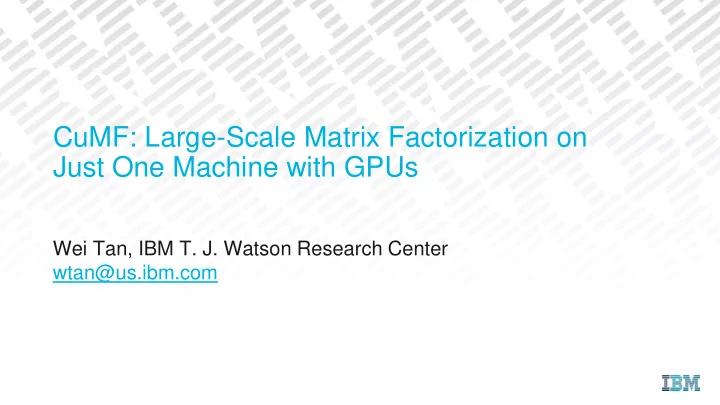

CuMF: Large-Scale Matrix Factorization on Just One Machine with GPUs Wei Tan, IBM T. J. Watson Research Center wtan@us.ibm.com
Agenda Why accelerate recommendation (matrix factorization) using GPUs? What are the challenges? How cuMF tackles the challenges? So what is the result? 2
Why we need a fast and scalable recommender system? Recommendation is pervasive Drive 80% of Netflix’s watch hours 1 Digital ads market in US: 37.3 billion 2 Need: fast, scalable, economic 3
ALS (alternating least square) for collaborative filtering Input : users ratings on some items Output : all missing ratings θ v Θ T How: factorize the rating matrix R into and minimize the lost on observed ratings: x u X ALS: iteratively solve R 4
Θ T Matrix factorization/ALS is versatile θ v Θ T Word word X embedding x u user word X Θ T item Recommendation Topic document X model a very important algorithm to accelerate word 5
Challenges of fast and scalable ALS • ALS needs to solve: LU or Cholesky decomposition: cublas spmm: cublas • Challenge 2: Single GPU can NOT handle big m , n and nnz • Challenge 1: access and aggregate many θ v s: irregular ( R is sparse) and memory intensive 6
Challenge 1: memory access 4.3T × fully-utilized Gflops/s under-utilized 288G × 15 1 Operational intensity (Flops/Byte) Nvidia K40: Memory BW: 288 GB/sec, compute: 4.3 Tflops/sec Higher flops higher op intensity (more flops per byte) caching! 7
Address challenge 1: memory-optimized ALS • To obtain 1. Reuse θ v s for many users 2. Load a portion into smem 3. Tile and aggregate in register 8
Address challenge 1: memory-optimized ALS T f T T T f 9
Address challenge 2: scale-up ALS on multiple GPUs Model parallel: solve a portion of the model model parallel 10
Address challenge 2: scale-up ALS on multiple GPUs Data parallel: solve with a portion of the Data parallel training data model parallel 11
Address challenge 2: parallel reduction Data parallel needs cross-GPU reduction One-phase parallel reduction. Two-phase parallel reduction. Intra-socket Inter-socket 12
Recap: cuMF tackled two challenges • ALS needs to solve: LU or Cholesky decomposition: cublas spmm: cublas • Challenge 2: Single GPU can NOT handle big m , n and nnz • Challenge 1: access and aggregate many θ v s: irregular ( R is sparse) and memory intensive 13
Connect cuMF to Spark MLlib ALS apps cuMF JNI mllib/ALS Spark applications relying on mllib/ALS need no change Modified mllib/ALS detects GPU and offload computation Leverage the best of Spark (scale-out) and GPU (scale-up) 14
Connect cuMF to Spark MLlib RDD on CPU: to distribute rating data and shuffle parameters Solver on GPU: to form and solve Able to run on multiple nodes, and multiple GPUs per node shuffle shuffle … RDD RDD RDD RDD RDD RDD RDD RDD RDD RDD RDD RDD … … … CUDA CUDA CUDA CUDA CUDA CUDA kernel kernel kernel kernel kernel kernel GPU1 GPU2 GPU1 1 Power 8 node + 2 K40 1 Power 8 node + 2 K40 15
Implementation In C (circa. 10k LOC) CUDA 7.0/7.5, GCC OpenMP v3.0 Baselines: – Libmf: SGD on 1 node [RecSys14] – NOMAD: SGD on >1 nodes [VLDB 14] – SparkALS: ALS on Spark – FactorBird: SGD + parameter server for MF – Facebook: enhanced Giraph 16
CuMF performance • 1 GPU vs. 30 cores, CuMF slightly faster than libmf and NOMAD • CuMF scales well on 1, 2, 4 GPUs X-axis : time in seconds; Y-axis : Root Mean Square Error (RMSE) on test set 17
Effectiveness of memory optimization Aggressively using registers 2x • Using texture 25%-35% faster • X-axis : time in seconds; Y-axis : Root Mean Square Error (RMSE) on test set 18
CuMF performance and cost CuMF @4 GPUs ≈ NOMAD @64 HPC nodes • ≈ 10x NOMAD @32 AWS nodes CuMF @4 GPUs ≈ 10x SparkALS @50 nodes • ≈ 1% of its cost 19
CuMF accelerated Spark on Power 8 CuMF @2 K40s achieves 6+x speedup in training (193 sec 1.3k sec) • *GUI designed by Amir Sanjar 20
Conclusion Why accelerate recommendation (matrix factorization) using GPU? – Need to be fast, scalable and economic What are the challenges? – Memory access, scale to multiple GPUs How cuMF tackles the challenges? – Optimize memory access, parallelism and communication So what is the result? – Up to 10x as fast, 100x as cost-efficient – Use cuMF standalone or with Spark – GPU can tackle ML problems beyond deep learning! 21
Thank you, questions? Faster and Cheaper: Parallelizing Large-Scale Matrix Factorization on GPUs. Wei Tan, Liangliang Cao, Liana Fong. HPDC 2016 , http://arxiv.org/abs/1603.03820 Source code available soon. Wei Tan, IBM T. J. Watson Research Center wtan@us.ibm.com http://ibm.biz/wei_tan
Recommend
More recommend